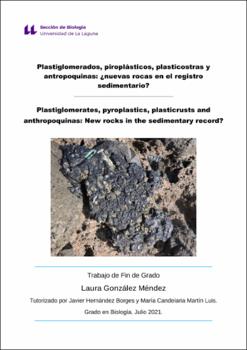Plastiglomerados, piroplásticos, plasticostras y antropoquinas: ¿nuevas rocas en el registro sedimentario?
Autor
González Méndez, LauraFecha
2021Resumen
La contaminación por plásticos y microplásticos, constituye uno de los problemas ambientales
más preocupantes en la actualidad. De hecho, la huella antropogénica que estamos dejando en el
planeta es de tal magnitud que ha llevado a diversos científicos a emplear el aún discutido término
del “Antropoceno” para referirse a la época actual en la que vivimos. Además, se han identificado
cuatro nuevos tipos de formaciones plásticas en los medios litorales que hasta ahora habían pasado
desapercibidos, los plastiglomerados, las plasticostras, los piroplásticos y las antropoquinas. Se trata
de un fenómeno muy reciente del que aún queda mucho por estudiar, pero se conoce que su formación
se debe a la llegada de residuos plásticos a los ambientes marinos, en los que son sometidos a
diferentes condiciones tanto ambientales como antropogénicas, que les otorgan nuevas características
respecto a su composición y sus propiedades fisicoquímicas. Esto hace que los impactos que éstos
provoquen en los ecosistemas sean potencialmente diferentes de los provocados por los
contaminantes plásticos hasta ahora conocidos y estudiados. Por lo tanto, queda mucho por investigar
acerca de estos nuevos contaminantes, así como el determinar una metodología de estudio y muestreo
estandarizada para cada una de estas formaciones. Pollution due to plastics and microplastics is one of the most worrying environmental
problems today. In fact, the anthropogenic footprint that we are leaving on the planet is of such
magnitude that it has led various scientists to use the still disputed term “Anthropocene” to refer to
the current time in which we live. In addition, four new types of plastic formations have been
identified in coastal environments that until now had gone unnoticed: plastiglomerates, plasticrusts,
pyroplastics and anthropoquinas. It is a very recent phenomenon about which there is still much to
study, but it is known that its formation is due to the arrival of plastic waste to marine environments,
in which they are submitted to different environmental and anthropogenic conditions, which give
them new characteristics regarding composition and physicochemical properties. This means that the
impacts they will cause on the ecosystems are potentially different from those caused by plastic
pollutants so far known and studied. Therefore, much remains to be investigated about these new
pollutants, as well as determining a standardized study and sampling methodology for each of these
formations.





